All the things that are falsy, including an array with one item that is falsy itself, which gets recursive.
English posts
I’m in the train between Leiden and The Hague and for almost the full ten minutes of that trip, two trains ride next to each other at about the same speed. Very cinematic to see. (Although I admit this video has too much reflection to be truely cinematic.)
[laravel/ideas] Calling a Pipeline multiple times
So, currently the Illuminate\Pipeline\Pipeline is used for Route Middleware and Job Middleware. In both cases, the Pipeline is used once: you new up an Instance and pass it the Request or Job, then use the result. It is clearly optimized for that use case.
I have a use-case in which I would like to call a single Pipeline (consisting of the same pipes) over and over again. When I used the Pipeline as is, I was surprised to learn that each time I run the pipeline with ->then(), I would get new instances of my Middleware. An example:
$pipeline = resolve(Pipeline::class)
->through($pipes);
$handle = fopen('logs.txt', 'r');
while ($line = fgets($handle)) {
$result = $pipeline
->send($line)
->then(fn($line) => $line);
// ...
}This will create new instances of all $pipes for each line in the file. This is undesirable if you want to do something with the lines based on a state of the pipe. As a silly example:
class LogRowCounter
{
protected $counter = 0;
public function handle($line, $next)
{
$this->counter++;
return $next($this->counter . ' - ' . $line);
}
}Apart from resolving all the $pipes, a lot of checks are also done while running the pipeline, meaning it happens in the while loop of my example. Some of those things could be done beforehand.
Reusable Pipeline
To make the Pipeline reusable, I would propose a new method called prepare(). (I was also thinking about compile(), but ‘prepare’ is used in some protected methods of Pipeline already.) It would extract running the array_reduce() from then() and return the resulting closure, and then() can call it.
public function prepare(Closure $destination)
{
$pipeline = array_reduce(
array_reverse($this->pipes()), $this->carry(), $this->prepareDestination($destination)
);
return $pipeline;
}
public function then(Closure $destination)
{
$pipeline = $this->prepare($destination);
return $pipeline($this->passable);
}This would still resolve all the pipes on ‘runtime’ though, because of how the closures are structured. Here is a new version of carry(), which resolves the pipes outside of the returned closure. The outer closure returned is meant for array_reduce(), like the current version; didn't want to refactor that.
protected function carry()
{
return function ($stack, $pipe) {
if (is_string($pipe)) {
[$name, $parameters] = $this->parsePipeString($pipe);
$pipe = $this->getContainer()->make($name);
} else {
$parameters = [];
}
return function ($passable) use ($stack, $pipe, $parameters) {
try {
if (is_callable($pipe)) {
return $pipe($passable, $stack);
}
$parameters = array_merge([$passable, $stack], $parameters);
$carry = method_exists($pipe, $this->method)
? $pipe->{$this->method}(...$parameters)
: $pipe(...$parameters);
return $this->handleCarry($carry);
} catch (Exception $e) {
return $this->handleException($passable, $e);
} catch (Throwable $e) {
return $this->handleException($passable, new FatalThrowableError($e));
}
};
};
}All Pipeline tests pass, and the following new test would pass too:
public function testPipelinePrepared()
{
$pipeline = (new Pipeline(new Container))
->through([
PipelineTestPipeOne::class,
PipelineTestStatefulPipe::class
])
->prepare(function ($piped) {
return $piped;
});
$result = $pipeline('foo');
$this->assertSame('foo', $result);
$this->assertSame('foo', $_SERVER['__test.pipe.one']);
$this->assertSame([], $_SERVER['__test.pipe.state']);
$result = $pipeline('bar');
$this->assertSame('bar', $result);
$this->assertSame('bar', $_SERVER['__test.pipe.one']);
$this->assertSame([0, 1], $_SERVER['__test.pipe.state']);
unset($_SERVER['__test.pipe.one']);
unset($_SERVER['__test.pipe.state']);
}
}
class PipelineTestStatefulPipe
{
protected $count = 0;
public function handle($piped, $next)
{
$_SERVER['__test.pipe.state'][] = $this->count++;
return $next($piped);
}
}Things to note
First off: I’ve taken the liberty to rename the ! is_object($pipe) check to is_string($pipe), because the very next thing we do is call $this->parsePipeString($pipe) with it.
Because of the way the closure is bound, the following code would work, and it seems like I can put it to use, but it looks wonky and weird too:
$filename = 'logs.txt';
$pipeline = resolve(Pipeline::class)
->through($pipes);
$run = $pipeline->prepare(fn($line) => $line);
// Call all `init($filename, $next)` methods
$pipeline->via('init');
$run($filename);
// Set method back to 'handle'
$pipeline->via('handle');
$handle = fopen($filename, 'r');
while ($line = fgets($handle)) {
// Call all `handle($line, $next)` methods
$result = $run($line);
// ...
}… that syntax makes me feel like Pipeline should store the Closure as a property somewhere, so prepare() returns $this, and then add an __invoke() or run() to Pipeline, so you can at least use the same variable instead of $pipeline and $run.
Alternative solutions
While we could do the above, I also have a different solution: singletons in the Container.
I originally rejected this (hence the work above) because I don’t want my stateful pipes to be global singletons. I want the pipes to belong to the Pipeline: if the Pipeline goes, so go the references to the pipes.
Think for example of the above file-handling example, but as a queued Job: I don’t want the state of the pipes from one run to be around when I process the next log-file.
But: this last point can also be resolved by creating a new Container instance per Job, and giving that to the Pipeline while constructing it. You can bind singletons into that separate container, which will belong to the pipeline.
Note that in that case – if we don’t change the Pipeline class – you’re still making the calls to the Container on ‘runtime’, which is not optimal. On the other hand, it might not be a very big deal.
I don't really like the way I have to new-up or resolve the Pipeline in this case, but it is doable.
I’d be happy to work this into a PR, but I thought this might be a better start, especially since I’m still debating whether or not I got a point here.
Thanks for reading, I’m curious about your thoughts.
Really liking the arrow functions in PHP 7.4 so far! Unfortunately already found one missing feature: you can't throw Exceptions from them. The following results in a 'unexpected T_THROW' syntax error:
fn() => throw new Exception('nope');Would've cleaned up my test, but alas.
It’s still a Thinkpad though, so not sure if it counts.
Introducing dark mode
Like a few others this IndieWebCamp I added a dark mode to my website.
With iOS 13 having a dark mode, which toggles with sunrise and sunset if you want it to, I all of the sudden like to have it on. And yesterday in the train, I noticed that my site felt kind of bright.
So this morning I hacked it together in the train back to Amsterdam. I went the dirty way: just have one media-query for determining dark mode, and then target a lot of elements and classes inside that, and set their color to be something different.
The actual implementation was not that hard (@media (prefers-color-scheme: dark)), but I spent the most time of the traintrip figuring out which darker grayscales should replace the brighter grayscales.
One thing to note here was the tip by Steve Schoger I remembered reading: dark modes are not about just inverting colors. Important elements in your UI should still be brighter than others.
Luckily, I don’t have a very complex UI on my weblog, but it’s worth to note that I took some time to make my month overview pages look nice in both modes. Feel free to compare the two.
Note that I currently don’t have a switch on my site to make you choose, but if your browser / OS tell my site which mode it’s in, my site will adapt to that.
On the topic of scoring in NES Tetris, PAL vs. NTSC
tl;dr: This is nerding out on Tetris scores, and quite frankly, I don't think the conclusion holds. But there are nice tables along the way.
I've been watching Classic Tetris for a few months now, and as a result, I'm also playing it. I am noticeably better after I watched some pro's scoring Tetris after Tetris at level 19, so I keep this pace of watching, playing, watching playing.
There is a problem though: at first I deemed playing at level 18 myself impossible, it's just too fast. Then I noticed how my mind could keep up with the players on the screen, but not with the pieces falling on my screen. Of course, I need more practice, but I have an excuse: I live in Europe.
Turns out old European TVs have a different refresh-rate than Americans. Therefore Tetris on the European PAL systems gets faster in earlier levels than the American NTSC systems. There is a nice article by Tetris Finland about this and other differences between the two versions.
Despite the faster speeds of the PAL version, I found no evidence of the scoring system being different. This means the PAL version is just harder, you just get less points for your hard work. (Yea, I will come back at this.)
I am playing Tetris on a real NES, brought ±15 years ago on a flee market at the local community playground for the insane price of 10 euros. The cartridge of Tetris has cost me more. But to compare myself with the pro's on screen I would have to spend a bit more to import an American NES.
Isn't there a way to calculate the NTSC score based on a PAL score?
Yea, is there a way to calculate NTSC score?
My current, not too impressive high-score on PAL is 174_731 (and yes I will use underscores here). How much is that worth on NTSC?
My first attempt was to look at the maximum scores. Players have been known to 'max out' the game on NTSC. A max out score is a score that is higher than 999_999, at which point the score will freeze on those six nines.
On the PAL version, however, we still have a world record, which is currently set to 758_360 by Joseph Saelee. This video is also a demonstration of how much harder the PAL game gets. (Although Joseph has a talent of making Tetris look easy on all versions.)
With some tweaks in the software you can get Tetris to report past 999_999, so higher scores are known. But for simplicity, let's take the world record and equate it with a NTSC max out score. This gives us ntsc = pal / 758_360 * 999_999, which will give me a NTSC score of 230_406.
But is that accurate?
It's always comparing apples with oranges, but I feel like this formula is a bit too loose. Let's bring in the information of the aforementioned article of Tetris Finland, which gives a nice table that compares the different frame rates, and calculates per level the time it takes, in seconds, to drop 20 spaces. Here is a table with that data:
| Level | NTSC | PAL |
|---|---|---|
| 9 | 1.996 sec | 1.999 sec |
| 10-12 | 1.663 sec | 1.599 sec |
| 13-15 | 1.331 sec | 1.199 sec |
| 16-18 | 0.998 sec | 0.7998 sec |
| 19-28 | 0.6655 sec | 0.39994 sec |
| 29+ | 0.33278 sec | as above |
Now, the scoring stays the same in both versions, but changes per level. Let's bring that down to a single number per level, let's agree on a perfect score.
The best way of scoring points is to only score tetrises (clear 4 lines at once). Each tetromino is made up of 4 blocks, and the board is 10 blocks wide. A perfect score would be if the Random Number Generator (RNG) gives us only lines and we can stand them up over the full width of the board, resulting in a tetris and an all-clear board each 10 pieces. This is not really achievable, but this would be the best score possible.
According to the Tetris Wiki we get 1200 * (level + 1) for each tetris, and scores are calculated based on the level after the line clear. Let's ignore push-down points. Let's also say that if the drop speed goes below 0.5 sec for 20 spaces the game is over (this makes levels 29 for NTSC and 19 for PAL the kill screens).
Then there is the concept op the start level. When you start at level 1, you go up to level 2 after 10 lines. But when you start at level 18, you get 130 lines before going to level 19, after which you get a new level ever 10 lines again. The Tetris Wiki gives the formula of "(startLevel × 10 + 10) or max(100, (startLevel × 10 - 50)) lines, whatever comes first". This means 100 lines for levels 9-15, then 110, 120 and 130 for 16, 17 and 18.
So I wrote this odd-looking piece of Javascript (because it's my day off and I can do whatever) to list out the various perfect scores for the various level-starts.
const killscreen = 19 // or 29
tetrisScore = level => 1200 * (level + 1)
startlevelLines = level => Math.min(
(level * 10 + 10),
Math.max(100, (level * 10 - 50))
)
scoreForLevel = (level, lines) => ({
score: (Math.floor(lines / 4) * tetrisScore(level)),
restlines: lines % 4
})
restlevelScore = (level, rest) => {
if (level >= killscreen) return tetrisScore(level)
const {score, restlines} = scoreForLevel(level, 10 + rest)
return score + restlevelScore(level + 1, restlines)
}
perfectScore = level => {
const {score, restlines} = scoreForLevel(level, startlevelLines(level))
return score + restlevelScore(level + 1, restlines)
}
const levels = [...Array(killscreen).keys()]
levels.map(level => console.log(`| ${level} | ${perfectScore(level)}`))I was kind of surprised by the results: as you can see, the world record by Joseph is higher than the perfect score. This is because he had a 100% tetris rate, burned one line in level 18 for 760 points, then tetrised into level 19, and then made a few singles and doubles in level 19. My definition of 'kill screen' seems too strict, but at least it's even on both sides of the table.
| Start level | NTSC perfect | PAL perfect |
|---|---|---|
| 0 | 1_332_000 | 588_000 |
| 1 | 1_334_400 | 590_400 |
| 2 | 1_340_400 | 596_400 |
| 3 | 1_348_800 | 604_800 |
| 4 | 1_360_800 | 616_800 |
| 5 | 1_375_200 | 631_200 |
| 6 | 1_393_200 | 649_200 |
| 7 | 1_413_600 | 669_600 |
| 8 | 1_437_600 | 693_600 |
| 9 | 1_464_000 | 720_000 |
| 10 | 1_478_400 | 728_400 |
| 11 | 1_454_400 | 710_400 |
| 12 | 1_462_800 | 712_800 |
| 13 | 1_432_800 | 688_800 |
| 14 | 1_435_200 | 685_200 |
| 15 | 1_399_200 | 655_200 |
| 16 | 1_429_200 | 685_200 |
| 17 | 1_461_600 | 717_600 |
| 18 | 1_497_600 | 753_600 |
| 19 | 1_536_000 | |
| 20 | 1_578_000 | |
| 21 | 1_622_400 | |
| 22 | 1_670_400 | |
| 23 | 1_720_800 | |
| 24 | 1_774_800 | |
| 25 | 1_831_200 | |
| 26 | 1_891_200 | |
| 27 | 1_953_600 | |
| 28 | 2_019_600 |
Given that my high score was a level-5-start score of 174_731, I should use ntsc = pal / 631_200 * 1_375_200, giving me a NTSC score of 380_687, a lot more than my previously calculated 230_406. But is this fair now?
Score per second
The table above is not by any means a fair comparison. It does account for the higher scoring potential in NTSC, but it still compares levels regardless of the speed they are played at. Let's combine the previous two tables into one.
So in the PAL version, you get less points, but also less time to think about how to score them. In that regard, the PAL version is harder, and the points should be worth more.
In the next table, I've taken the perfect score per level, and divided it by the thinking time you have for it (the seconds of the earlier table times 240, the number of lines before transition you get when you start in level 29). The result is a series of numbers that say how 'easy' it was to get that number of points.
| Start level | NTSC score | sec / 20 lines | modifier |
|---|---|---|---|
| 9 | 1_464_000 | 1.996 | 3.0561122244 |
| 10 | 1_478_400 | 1.663 | 3.7041491281 |
| 11 | 1_454_400 | 1.663 | 3.6440168370 |
| 12 | 1_462_800 | 1.663 | 3.6650631389 |
| 13 | 1_432_800 | 1.331 | 4.4853493614 |
| 14 | 1_435_200 | 1.331 | 4.4928625094 |
| 15 | 1_399_200 | 1.331 | 4.3801652893 |
| 16 | 1_429_200 | 0.998 | 5.9669338677 |
| 17 | 1_461_600 | 0.998 | 6.1022044088 |
| 18 | 1_497_600 | 0.998 | 6.2525050100 |
| 19 | 1_536_000 | 0.665 | 9.6240601504 |
| 20 | 1_578_000 | 0.665 | 9.8872180451 |
| 21 | 1_622_400 | 0.665 | 10.1654135338 |
| 22 | 1_670_400 | 0.665 | 10.4661654135 |
| 23 | 1_720_800 | 0.665 | 10.7819548872 |
| 24 | 1_774_800 | 0.665 | 11.1203007519 |
| 25 | 1_831_200 | 0.665 | 11.4736842105 |
| 26 | 1_891_200 | 0.665 | 11.8496240602 |
| 27 | 1_953_600 | 0.665 | 12.2406015038 |
| 28 | 2_019_600 | 0.665 | 12.6541353383 |
| Start level | PAL score | sec / 20 lines | modifier |
|---|---|---|---|
| 9 | 720_000 | 1.999 | 1.5007503752 |
| 10 | 728_400 | 1.559 | 1.9467607441 |
| 11 | 710_400 | 1.559 | 1.8986529827 |
| 12 | 712_800 | 1.559 | 1.9050673509 |
| 13 | 688_800 | 1.199 | 2.3936613845 |
| 14 | 685_200 | 1.199 | 2.3811509591 |
| 15 | 655_200 | 1.199 | 2.2768974145 |
| 16 | 685_200 | 0.799 | 3.5732165207 |
| 17 | 717_600 | 0.799 | 3.7421777222 |
| 18 | 753_600 | 0.799 | 3.9299123905 |
This would say an NTSC max-out on a level 18 start is 999_999 / 6.25250501, so has a difficulty of 159_935. The world record on PAL is 758_360 / 3.9299123905, so has a difficulty of 192_971. To me this feels believable, because Joseph has had many beyond-max-out games. We don't know their scores, because the game does not tell us, but their difficulty might also approach 200k.
And my score? Well, as I mentioned somewhere it was a level-5-start score, and as you can see in the first table: there is not much difference between level 9 on PAL and NTSC, and level 5 is not even listed. I should really stop whining and just practice more.
Apples and oranges
If you actually read the article by Tetris Finland you already would know: the speed is not the only difference. There are also differences in the way DAS works in PAL vs NTSC. The article concludes that these games are therefore very different, so different that you might consider them entirely different titles, despite looking the same.
It was fun figuring out these numbers and formula's, but in the end, you really can't compare the two. Gotta fix myself an NTSC somewhere if I want to compare my progress to the pro's.
Note that this difficulty number is a thing I invented in this post, and it is in itself not comparable to Tetris scores. But you can compare it to other difficulty numbers, if you calculate them the same way. Actually, I don't really think this whole thing is reliable at all, but I didn't want to throw a whole morning of calculating and writing out of the window. Some of the tables bear more value than others.
Some other weird things about falsy Javascript:
false == false
0 == false
[] == false
"" == false
"0" == false
"\t" == false
[] == false
["0"] == false
[[["0"]]] == false
[[[1 - 1]]] == false
[[[{}.foobar]]] == false
[[[`\t ${[].length} \t`]]] == false
// BUT
[false] != falseSo, yesterday I learned that [] == [] is false in Javascript. Today my adventures with arrays lead me to this:
const coffees = ['espresso', 'latte', 'filter']
console.log(
'filter' in coffees,
'cappuchino' in coffees,
'espresso' in coffees
)
// => true, false, falseYou need a certain confidence in writing your own authz-code. Part of the value of the package is verfication that it is a proved pattern. I think that would especially apply to auth(n), as we are thaught not to roll our own. But this seems very straightforward once you read it.
Ah, I think I got myself an answer: the const variant does not allow re-definition of the function, while the function variant does. I still don't think the benefit that brings outweighs the ugliness of it. Can I have a new keyword like fn or something to solve this?
I don't understand why people prefer arrow-functions in Javascript in the following context:
const name = () => stuff();vs
function name() {
stuff();
}... they are ideal for callbacks and map-operations, but when I want to declare a function, I want to see that keyword.
Feels even more useful with reduce():
console.log([
x => x + 36,
x => `The answer is ${x}!`,
x => x.toUpperCase(),
].reduce((x, fn) => fn(x), 6));
// THE ANSWER IS 42!Oh, no I got links to neither... I was not actually planning on sending this in to the contest, it feels too simple. But I might clean it up and send it in, and then those links will come. (Also: what is the licensing model behind Tetris?)
Mobile is hard, btw, because Tetris relies on buttons so much. I can add some buttons to the page, but I'm afraid the game play won't be as good. Most mobile Tetrises I've seen do fancy things with gestures, but it always feels odd to me. It's just not a touch game :)
So, I've been addicted to Tetris for the last week or so. Last night I decided to do something else, and when I came across the Phoenix LiveView contest, I thought: why not try and make Tetris? #myelixirstatus
I was surprised by how far I got. I have watched videos of people coding games before, have been coding myself for years and years, but somehow games felt out of my league. But here, after a (long) evening, I got a game! I should've streamed it myself.

I mean I'm standing of shoulders of giants. I got so much for free from Erlang/Elixir, LiveView to hook it up, @chris_mccord's Snake example gave me the basic idea of using just <div>'s for blocks, the browser is doing the drawing and key-repeats for me.
But it felt magical, once the game got playable. I was hooked again to my own creation. And so many "features" from NES Tetris like sliding, tucking and spinning "just worked" in my first implementation (probably because I was close to their implementation).
It all started with this HTML based board, using flexbox to to the hard works of blocks for me. I later wrapped the board in a Game-struct, and added bindings for the scores.
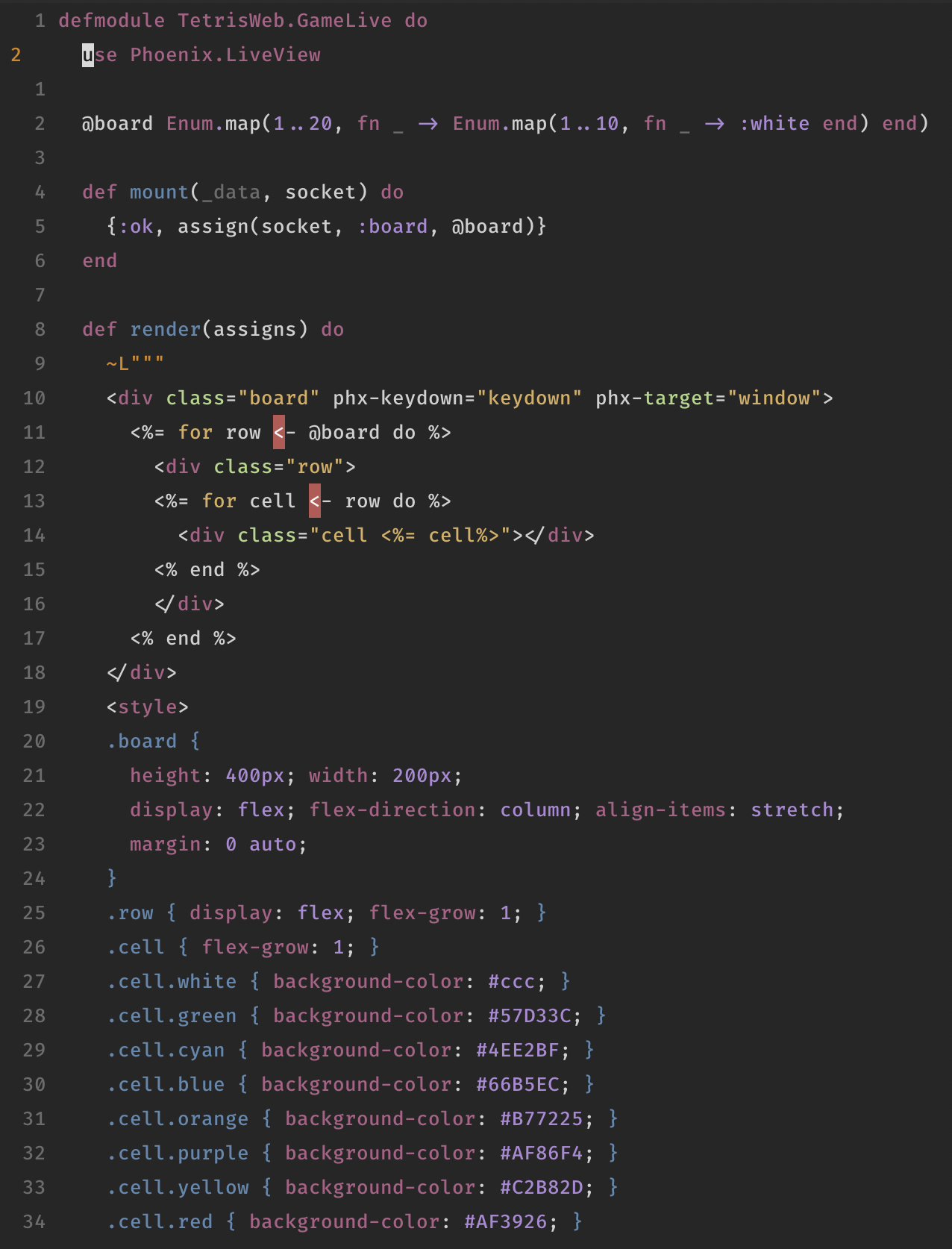
How to get a game loop in Elixir? Just send yourself a message after, say, 500ms. The LiveView component has a handle_info/2, which queues the next tick and moves the current Tetromino down.

Thanks to the phx-keydown="keydown" in the template, we get messages in handle_event/3 for each key. Just delegating to my Game module. And yes, I use Vim, so I need those H, J and L. (Dropping with K is not implemented.)
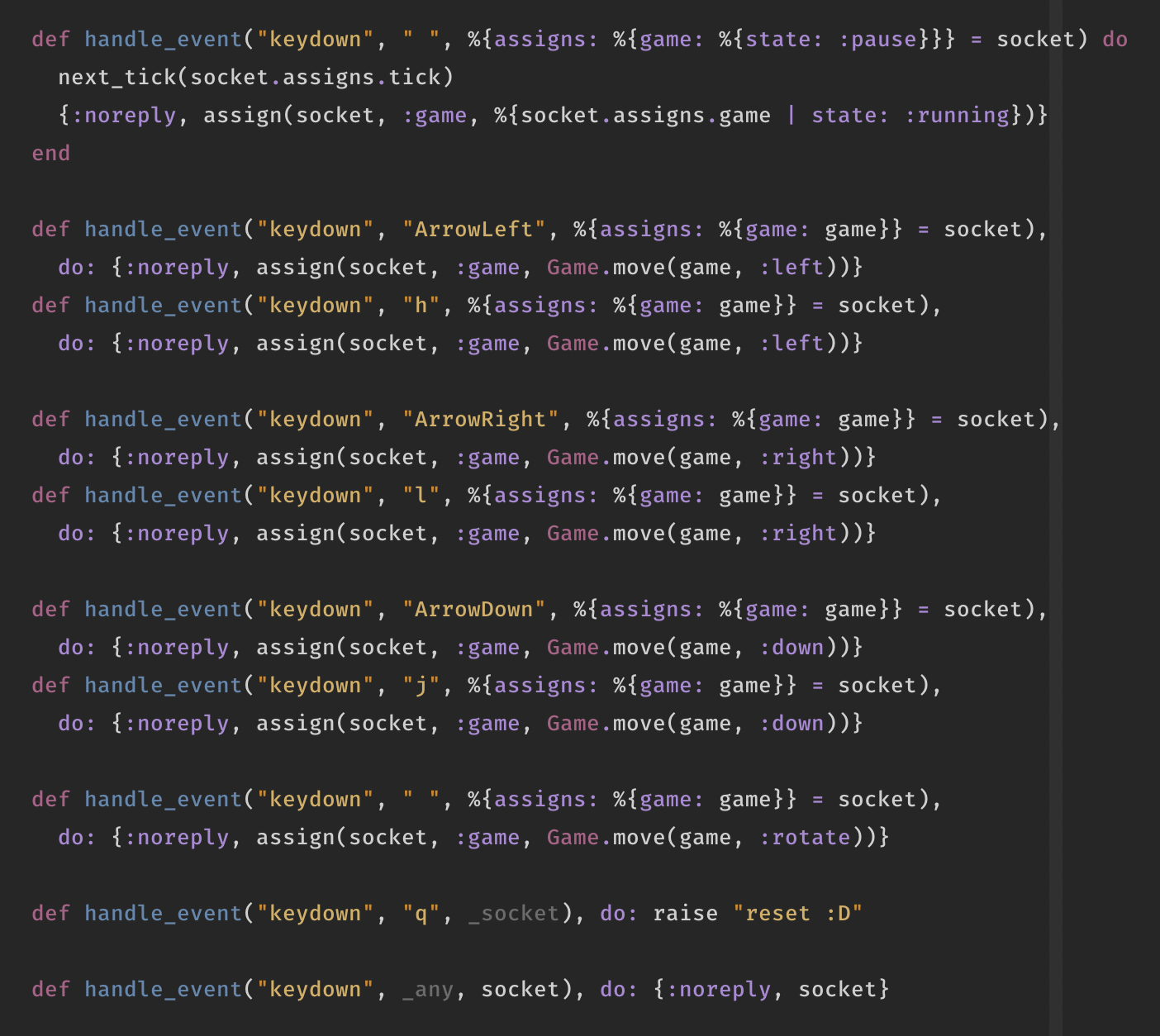
My Game.move/2 got a bit complicated, some refactoring is in place. But I started with a Tetromino struct, with :x and :y keys and a :color. To move it down, you paint the current :x and :y :white, and then paint :y + 1 to the :color. Code below reduces for all four points:
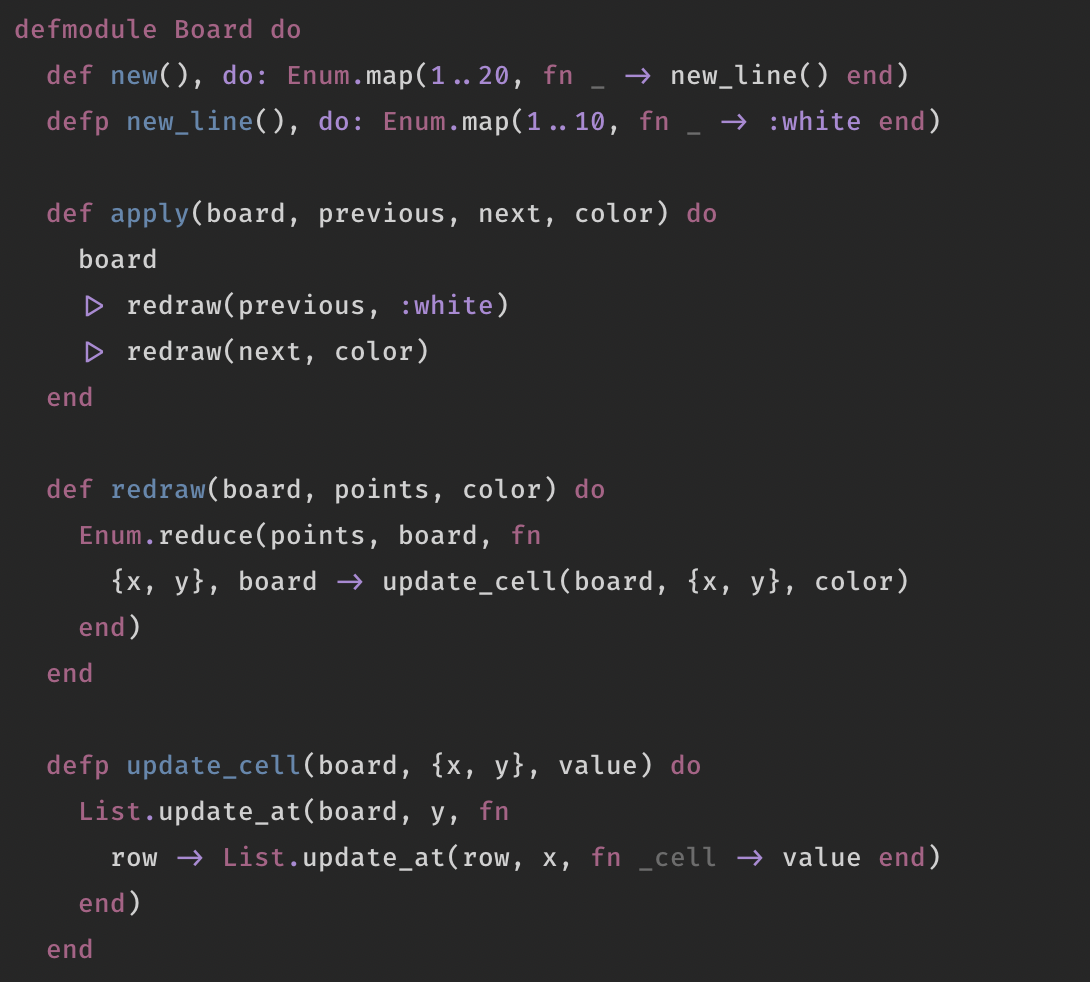
To obtain all the points I got this wonderful Tetromino.points/1 function. It's ugly and was a pain to write out and get right, but it works like a charm.

Colors and rotations work similar, with Tetromino.rotate/1. (color_for_type/1 gets called in new/1, and it never changes once it is created.)

Then the messy Game.move/1: can you move down? Move down. Otherwise, call Board.clear_lines/1 to remove full lines and obtain the score, get a new random Tetromino and put it on the board. The game-over handling is a bit buggy still, I had only one evening.
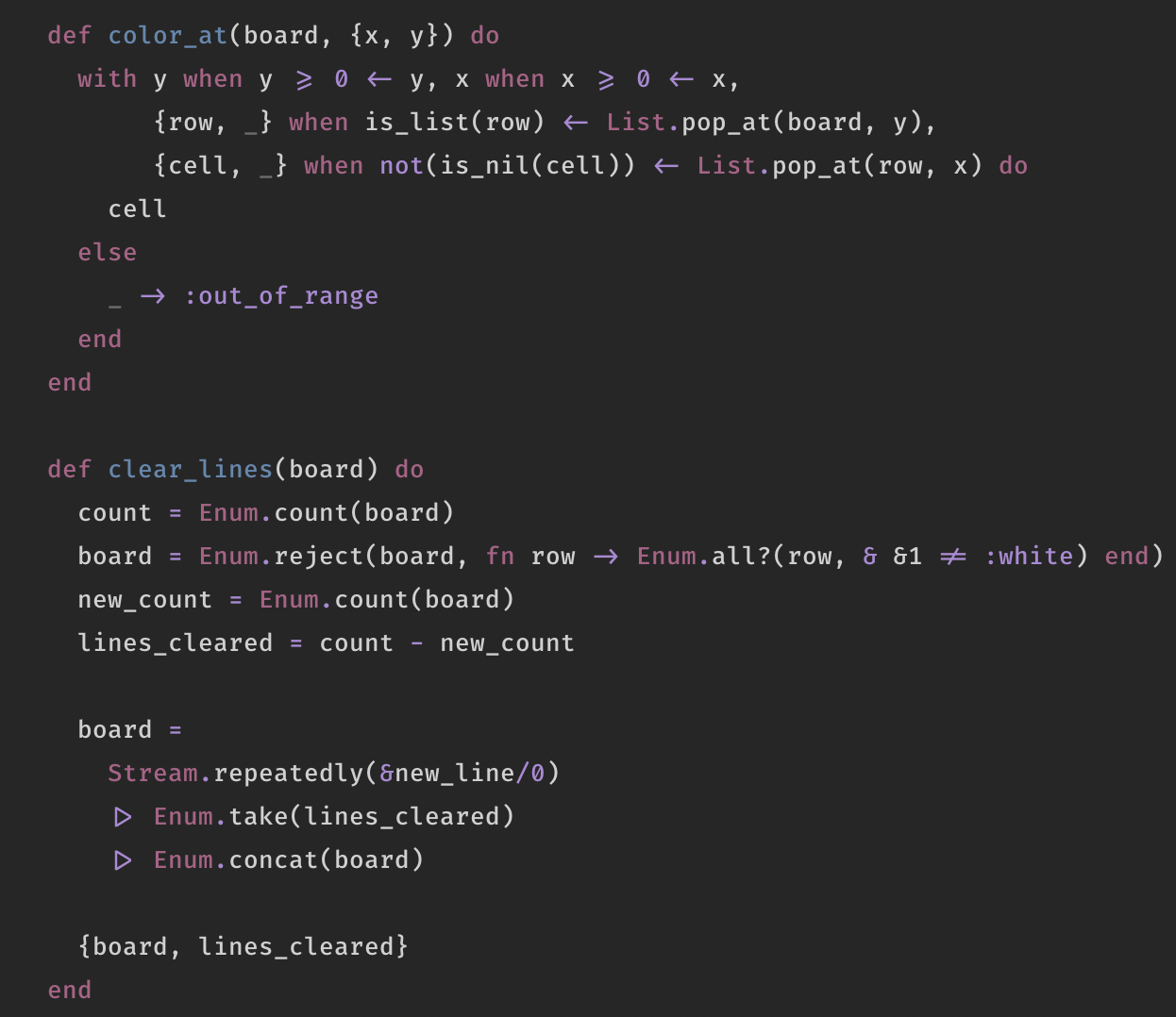
Clearing the board is simple: reject rows of which all cells are not empty and use counts to add new rows to the top. The Board.color_at/2 gives the color for that particular cell. The guards against negative numbers prevent List.pop_at/2 to get items from the back of the list :)
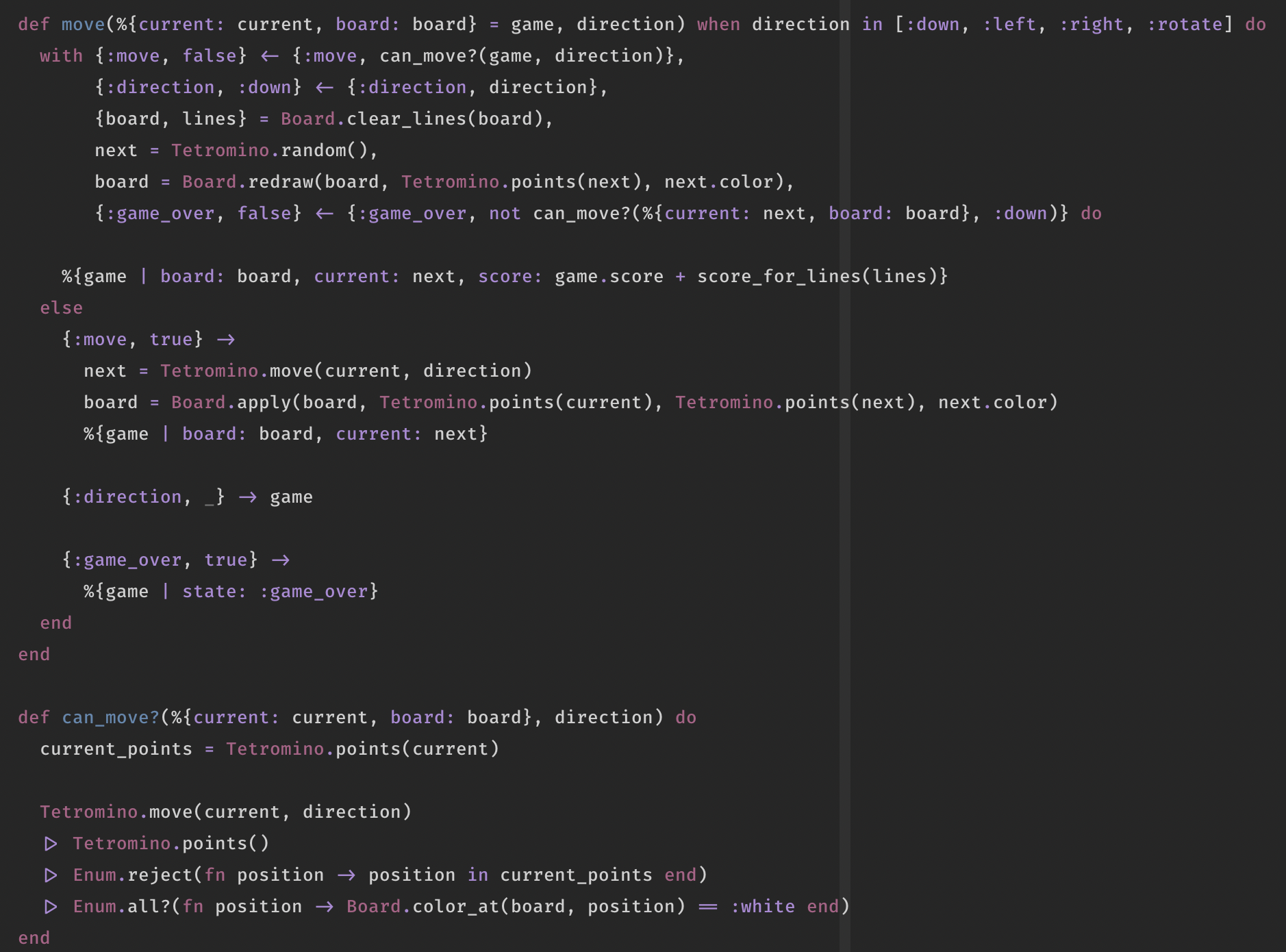
I think that's mostly it! Again, I wish I had streamed it, it was very weird watching myself doing it, but also very rewarding. Keep coding, people, you can do this too!
Hah, I thought you made an app to digitally manage the stickers on your laptop. That widget you got is so close. Plz provide a way to import stickers ;)
I think the answer would be Vouch. It's meant as a way to reduce what you display, but you can also say: ignore everything that has no vouch. No need to them. https://indieweb.org/Vouch
The only downside I see now is that you are binding your components to your GraphQL schema, but since that has reasonable deprecation management I think I'm okay with that.
Thanks! I'm considering introducing it to a project. It uses JS and Vue, but I think it can still be a match. A lot of props get passed around through many components, and this could be a way to just pass the whole object but still make sure all the fields are present.
@christoomey Hi Chris! This talk is not that old, but I was curious: are you still using this pattern of exporting GraphQL fragments from React components? Are you still happy with it and would you still recommend this approach? :)
https://www.youtube.com/watch?v=Qsoj4s_Ml6s
I just released a completely rewritten version of Gimme A Token, which hopefully does a better job of explaining the IndieAuth flow as you go.

 Twitter
Twitter Instagram
Instagram LinkedIn
LinkedIn Github
Github Strava
Strava Facebook
Facebook